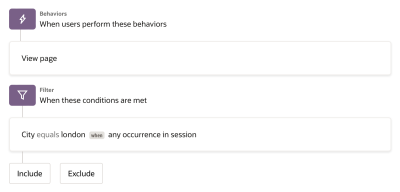Web Personalization Canvas
Note: This feature is currently released under our Controlled Availability program. To request access to this feature, please log in to My Oracle Support and create a service request. Availability for this feature is specific to product trim. Contact your account representative for more information.
The personalization canvas helps to serve custom visitor experiences based on Infinity. There are four node types available for setting up a web personalization.
The following nodes specify a condition in a user journey:
-
Trigger
-
Decision
The following nodes are called when the preceding condition is met:
-
Content
-
Stop content

You can have multiple nodes of each type to define the user journeys that suit your business needs.
Trigger node
A trigger is a set of behavioral rules. A trigger and the succeeding non-trigger nodes (from left to right) comprise a user journey step. As soon as the behaviors of the first trigger take place on your website, the visitor is evaluated through the nodes of the step. All the immediate decision, content and stop content nodes get activated. Then the same happens with the following trigger as soon as the associated behaviors take place afterward.
The state of the visitor in a user journey is maintained between visits, unless specified differently with the Evaluation Type setting. This means that web personalization either operates for the whole lifetime of a visitor, or in the duration of one session only.
Web personalizations keep track of the visitor, which content should be displayed, and which behaviors should transition the visitor to the next step. A user journey is set up from left to right on the web personalization canvas.
Decision node
A decision is a traffic split. It is a yes or no filter that runs immediately when the preceding trigger or decision node is activated.
Content node
Content is a piece of HTML that is rendered on a web page as soon as the preceding trigger or decision activates it. Unlike the decision node, the content node keeps serving all the time until the corresponding stop content node is activated. Learn more about content editing.
Stop Content node
Stops serving the content you specify.
Understanding the canvas
A trigger on the personalization canvas serves as the main user journey building block and splits the journey into steps.
The behaviors you specify for a trigger are calculated only after the preceding trigger was activated. This means that if you set three triggers that expect the same event, a visitor would need to perform that activity three times to move through those triggers. Similarly, if you specify an event for triggers that only happens once per session, it would take a session to pass through each of those triggers.
For instance, consider a visitor traveling from London to New York. A trigger that filters for city equal to new york on any occurrence in session makes the visitor eligible to proceed through the step.
But then the next trigger qualifying for london would only comply if the visitor travels back to London again.
A user journey starts from the very first trigger (on the left) and assigns a state to the visitor with every condition (trigger and decision) being met. Whenever a visitor reaches the end of the user journey and finds all content stopped being served as per the stop content nodes configurations, the journey ends, and the visitor no longer participates in this personalization.
Web Personalization Content Editing






